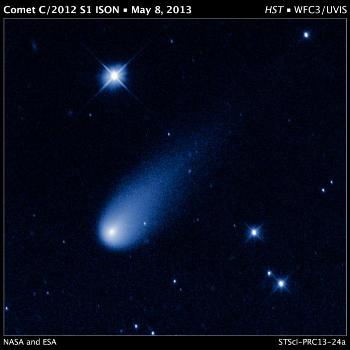Jul 3 2013
This July Fourth the solar system is showing off some fireworks of its own. Superficially resembling a skyrocket, comet ISON is hurtling toward the sun presently at a whopping 48,000 mph.
 This false-color, visible-light image was taken with Hubble’s Wide Field Camera 3. Image Credit: NASA, ESA, and the Hubble Heritage Team (STScI/AURA)
This false-color, visible-light image was taken with Hubble’s Wide Field Camera 3. Image Credit: NASA, ESA, and the Hubble Heritage Team (STScI/AURA)
Its swift motion is captured in this time-lapse movie made from a sequence of pictures taken May 8, 2013, by NASA’s Hubble Space Telescope. At the time the images were taken, the comet was 403 million miles from Earth, between the orbits of Mars and Jupiter.
The movie shows a sequence of Hubble observations taken over a 43-minute span and compresses this into just five seconds. The comet travels 34,000 miles in this brief video, or 7 percent of the distance between Earth and the moon. The deep-space visitor streaks silently against the background stars.
Unlike a firework, the comet is not combusting, but in fact is pretty cold. Its skyrocket-looking tail is really a streamer of gas and dust bleeding off the icy nucleus, which is surrounded by a bright star-like-looking coma. The pressure of the solar wind sweeps the material into a tail, like a breeze blowing a windsock.
As the comet warms as it moves closer to the sun, its rate of sublimation (a process similar to evaporation in which solid matter transitions directly into gas) will increase. The comet will get brighter and its tail will grow longer. The comet is predicted to reach naked-eye visibility in November.
The comet is named after the organization that discovered it, the Russia-based International Scientific Optical Network.
This false-color, visible-light image was taken with Hubble’s Wide Field Camera 3.
The Hubble Space Telescope is a project of international cooperation between NASA and the European Space Agency. NASA’s Goddard Space Flight Center in Greenbelt, Md., manages the telescope. The Space Telescope Science Institute in Baltimore, Md., conducts Hubble science operations. STScI is operated by the Association of Universities for Research in Astronomy Inc., in Washington, D.C.